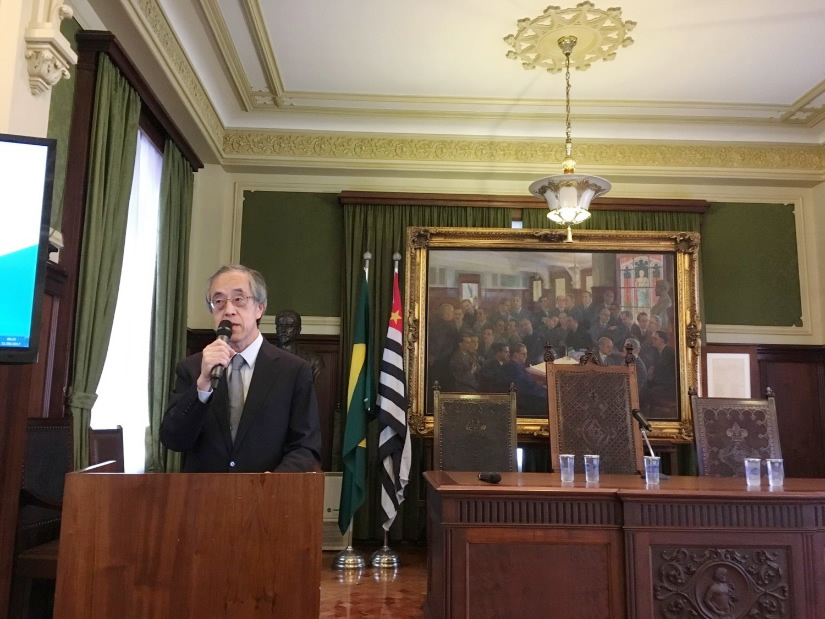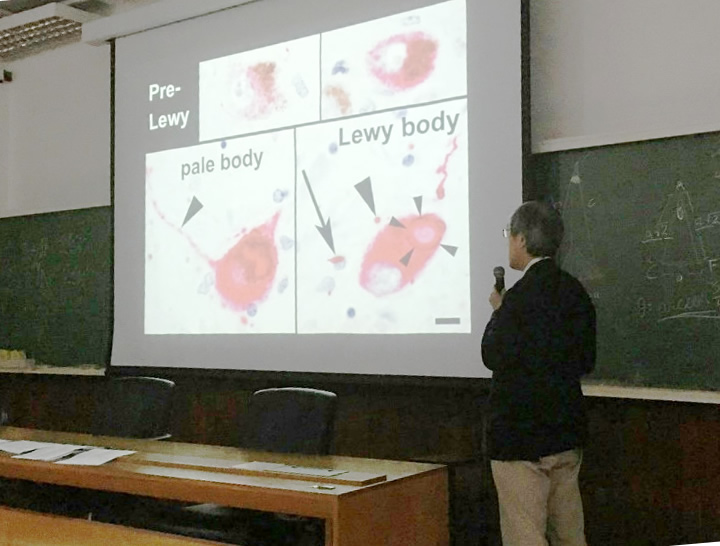- HOME
- Domestic and International Cooperation
- Report on Brain Bank’s financial independence in overseas
Report on Brain Bank’s financial independence in overseas
Shigeo Murayama
Bioresource Center, Department of Neurology, Tokyo Metropolitan Institute of Gerontology, and Neuropathology, the Brain Bank for Aging Research
I conducted interviews at the three conferences I attended: Alzheimer's Association International Conference (July 22-26, 2017 in London), International Conference held at Brain Bank Advanced Neuro Science, São Paulo University, Brazil, (August 27-Sep 5, 2017 in São Paulo), and Annual Meeting of the Japanese Society of Neurology (Sep 16-21, 2017 in Kyoto).
At the Alzheimer's Association International Conference, I reported the annual activities on behalf of National Center for Geriatrics and Gerontology. I took the opportunity to discuss with Professor Love (Editor in Chief of “Brain Pathology”) and Professor Holton (the head of Queen Square Brain Bank, and Editor in Chief of “Neuropathology and Applied Neurobiology”).
Prof. Love explained that UK Brain Banks are under national control based on the Human Tissue Act, a civilian legislation, drafted and enacted by researchers. Based on the consensus to conduct the cohort study, the organizing group charge 25 pounds per tissue since April 2016 to cover handling and transportation expenses. Audit Committee comprising members and researchers oversee the accountant to check the balance and make sure no profit is made. This is because it ensures the Brain Bank’s sustainability. Further, they treat NPO and PO as equal.
Professor Holton conduct the collaborative research with Professor Halliday (describe below) who serves as the principal researcher, on the theme of early change in diagnosis of Parkinson's diseases. The project is funded by Michael J Fox Foundation. She said the ratio of MRC research fund is small although to ensure the sustainability of the Brain Bank. She clearly stated that is the obligation to respect the donors who deposited the resources. The society overall thus has the obligation to support the project. She also emphasized the fee charged to users is spent on collecting, handling, and maintaining the resources. There is no intention to sell the resources.
Next, I visited Sao Paolo, Brazil to give presentations (Pictures 1 and 2) and conducted interviews at International Conference held at Brain Bank Advanced Neuro Science, São Paulo University, Brazil, with the support on travel expenses from Platform of Supporting Cohort Study and Biospecimen Analysis.
Their Brain Bank collects 13,000 cases a year as a baseline. The autopsies were conducted by public service sectors. Because Japanese Brazilians are included in the cases, I conduct a collaborative research on the comparison pathology with Associate Professor Nagahashi, at the department of neurology, the University of São Paulo. I gave a presentation on the joint research.
Brain Bank at the University of São Paulo places importance on comparison of GWAS research on multi-racial, and change in aging, with the support of NIH fund. Thus, the idea of Professor Benett (Principle Researcher) at Rush University has been greatly reflected. But both “Religious Order Study”, and ”Rush Longitudinal Study of Aging and Dementia” are conducted by Rush University and both are subjected to highly-educated Caucasian White. In addition, in São Paulo University’s Brain Bank, the medical doctors can’t issue the death certificate because the public sector is responsible for the autopsy and the donors have no medical record. I commented that the data has an inclusion bias, and the data needs to be adjusted to the general mortality statistics. We, the Japanese Brain Bank has the similar issues and acutely aware to overcome the drawback. Currently we have just started promoting the consent of brain donation registration in the Japanese Brazilian society to eliminate the bias.
Currently, Dr. Nagahashi conducts a joint research with the Netherlands so she introduced me Professor Huitinga who heads the Netherlands Brain Bank. The Bank contributes the most to the European counterpart. She told me that in the Netherlands, handling and management fees to maintain the Brain Bank are main responsibility for the researchers. She also told me about the PO’s use. When PO uses the resources, they need a written consent called Brain Bank registration Agreement to agree to use it to elucidate the method to cure the disease.
On the contrary, Japanese society of neuropathology has long been standing on the idea of late Professor Kretschmer at University of Munich who hosted German BrainNet. The idea is a principle organizer should open a donated lab in an university to conduct the research using the post-mortem brain in the lab. However, German BrainNet was supposed to continue its research for 10 years, but its budget was halved in the fifth year due to the lack of outcome, and the project ended in the 10th year. The point was German researchers themselves selected to use the brain resources from NIH funded Brain Bank. Professor Huitinga had an opposite view from Professor Kretchmer, support from PO is important in sustainability. So her opinion was persuasive in that making the organization open is important, and troubles can be avoided by obtaining the letter of consent when registration. She accepted my invitation to Brain Bank Symposium in Japan, organized by Japanese Society of Neuropathology that I will be the next President of JSNP.
Further, in the middle of September, Japanese Society of Neuropathology was held in Kyoto International Conference Center. His Imperial Highness Prince Akishino was invited at the opening ceremony. I, project researcher at National Center for Geriatrics and Gerontology, reported on the BioBank and Brainbank projects on aging. I talked with Professor Halliday who was the president of the Australasian Neuroscience Society, and who hosts the Brain Bank Parkinson's diseases in Sydney. She told me, in Australia, only dry ice and transportation costs are charged to researchers; similar to our consensus at Platform of Cohort and Biospecimen Analysis.
NIH-funded Brain Bank in the United States allows corporate researchers to use the resources as they like from its Brain Bank as long as their CEO countersign the documents. If they want to submit a patent application, the ratio of the Intellectual Property Right will be discussed between NIH and Brain Bank. NIH-funded Brain Bank is open to any international researchers to use the resources as long as they passed the academic review and ethical examination. Although Japanese researchers will find it hard to pass the academic review in the current circumstances.
Dr. Beach who hosts Sun City Body Donation Program in the U.S. told about his program. The program first provides small amount of samples for free to an applicant. But when the research project seems prosperous, they recognized the applicant as a joint researcher and start asking for the research fee. Corporate researchers need to pay additional fee; to maintain the program. I invited Dr. Beach to the Annual Meeting of the Japanese Society of Neurology in 2019. I hope to have a discussion with him at the international symposium to seek the Brain Bank’s sustainability.
At the three international conferences, I interviewed and learned the measures to ensure the sustainability of the Brain Banks in each country. We can’t depend on the competitive research grant only. Therefore we need have a viewpoint to support the system by the society of researchers, and we need to reach the consensus on providing the resources to corporations. As I was selected as President-elect of JSNP, I would like to promote the discussion and takes it up as the main theme. I deeply appreciate your cooperation and support.








